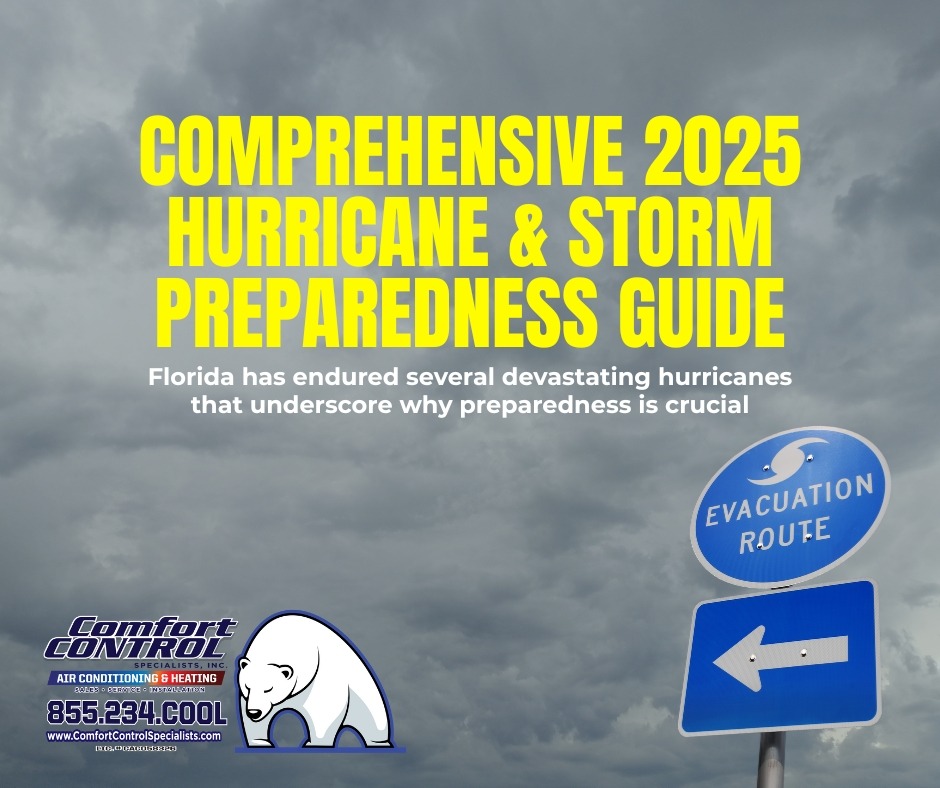2025 Comprehensive Hurricane & Storm Preparedness Guide
Below is a fully expanded and detailed hurricane and storm preparedness guide tailored for Spring Hill, FL, from Comfort Control Specialists. We’ve included in-depth advice for food, fuel, generators, HVAC systems, and safety, with real lessons from recent storms like Milton’s widespread fuel shortages and mass evacuations. The article is primarily informational, and concludes with a disclaimer per your request.
1. Why You Must Prepare Now
In recent years, Florida witnessed extraordinary hurricanes that unmistakably showed the importance of early and thorough preparedness:
Hurricane Ian (Sept 2022) began as a powerful Category 5 storm and caused $112 billion in damage. The storm surge battered homes, breached water systems, and left more than 2.4 million without power.
Hurricane Idalia (Aug 2023) rapidly intensified, causing significant flooding and outages.
Hurricane Helene (Sept 2024) knocked out power for 1.3 million Floridians and claimed dozens of lives.
Hurricane Milton (Oct 2024) triggered mandatory evacuations of over 1 million people, snarling evacuation routes and leading to widespread gas shortages — more than 88% of Tampa area stations ran dry (epa.gov).
With NOAA forecasting an above-average 2025 season (16–17 named storms, 7–9 hurricanes) , timing is critical. These storms underscore that last-minute prep can lead to shortages, flooding, and strained infrastructure. This guide covers every phase of preparation: before, during, and after a storm.
2. Month-by-Month Preparation
May–June: Foundation Stage
HVAC Preparation
Schedule a full professional maintenance check—inspect filters, coils, coolant lines, belts, and drainage.
Add a whole-system surge protector to minimize electrical damage.
Install the EasyStart Flex soft-start kit (on special this June) to reduce compressor strain during post-storm restarts.
Structural Readiness
Trim tree branches 15+ feet from your home to prevent roof damage.
Clean gutters and downspouts to avoid water backup.
Inspect shutters/plywood, reinforce garage doors, and prepare sandbags if needed.
Supplies & Logistics
Stock up water (1 gal/person/day, 7–14 days).
Keep non-perishable food: canned goods, MREs, protein bars, pet food.
Store cash, batteries, a battery-powered radio, flashlights, first-aid kits, and personal care items.
Fill gas tanks early—most critical for evacuation readiness and during supply-chain interruptions (businessinsider.com).
Have a transfer switch installed on your generator and test it monthly with fresh fuel.
48–72 Hours Before Storm
Run and test your generator with a load, confirm CO alarms and ventilation settings.
Protect outdoor HVAC units: secure with straps or cages; elevate in flood-risk areas .
Pre-cool your home with windows and blinds closed to maintain comfort during power loss.
Move all outdoor items indoors, including tools, grills, and furniture.
Freeze jugs of water to preserve refrigerator and freezer cold for longer .
Finalize go-bags: medications, IDs, cash, maps, child/pet necessities.
Secure windows and doors, clear remaining yard items, and position sandbags at entry points.
24 Hours Before Storm
Turn off the outdoor HVAC at the breaker or disconnect switch.
Top off generator fuel; ensure safety when storing gasoline.
Charge phones and power banks; confirm flashlights and radios are working.
Backup electronic and official documents in waterproof containers.
3. During the Storm
Follow evacuation orders and local instructions immediately.
Stay in interior rooms, away from windows.
Unplug all electronics to prevent electrical surges.
Use generators outdoors only, ensuring they are far from the house and never run in enclosed areas (cbsnews.com).
Cook outside using gas/stove equipment—never indoors.
Avoid unnecessary travel; roads may flood or be blocked.
4. Food, Water & Sanitation
Consume stored food systematically; rotate stock to avoid spoilage.
Use frozen water for fridge freezing power; use stored water for drinking and hygiene.
Use stored water for flushing toilets and cleaning.
Maintain hygiene supplies: wet wipes, hand sanitizer, diapers, personal care.
Keep a well-stocked medical/first-aid kit for minor injuries.
5. Fuel & Evacuation Insights
In Oct 2024, Tampa area gas stations hit 88% empty within hours of Milton’s landfall (wusf.org).
Mandatory evacuations impacted over 1 million residents, and traffic congested major evacuation routes, compounding fuel shortages (theguardian.com).
This picked up a pattern from Hurricane Irma (2017), when 6.5 million Floridians evacuated, causing fuel hoarding, escorted fuel trucks, and shoulder-lane use on I‑95.
Our takeaway: top off all tanks at the earliest storm watch—not when alerts escalate.
6. HVAC System—Storm Phase
Pre-Storm
Replace or clean filters to ensure optimal airflow.
Shield outdoor units from debris; tie them down if necessary.
Shut off at main disconnect if flooding is likely.
Install surge protection and consider the EasyStart Flex kit for smoother restarts.
Post-Storm
Inspect outdoor unit for flood damage, broken fins, or debris.
Allow professionals to check before full system restart.
Run a test on fan-only mode to verify airflow and system health.
Monitor for unusual smells or noises; schedule follow-up if problems persist.
7. Evacuation Planning & Considerations
Evacuation is stressful and costly. Some families during Milton spent over $2,300 for lodging, gas, meals (nypost.com).
Unexpected closures may make relocating impossible—local shelters, staying with out-of-area relatives, or emergency planning may be required.
Keep a “family go-bag” per person with essentials.
Create communications plans with family and establish a meeting point.
8. Post-Storm Recovery
Only return home once authorities signal it’s safe.
Avoid downed power lines and floodwater.
Keep generator outdoors with proper ventilation and storage.
Schedule HVAC and home inspections before resuming normal operation.
Document damages thoroughly with photos for insurance.
Listen to professionals—especially regarding electrical or water-damaged systems—to prevent longer issues like mold or system failure.
9. Long-Term Home & HVAC Resilience
Elevate HVAC units above flood lines and install protective housing.
Use corrosion-resistant HVAC equipment suited for coastal environments.
Employ whole-home surge protection.
Replace breakable windows with durable shutters or impact-rated glass.
Upgrade sump pumps and foundation waterproofing for flood resilience.
10. June Special—EasyStart Flex Soft-Start Kit
During June, take advantage of discounted EasyStart Flex installation, which:
Cuts compressor startup current by up to 70%
Reduces electricity spikes
Extends system longevity
Minimizes stress on both your HVAC and home electrical system
Contact us for more details or to schedule your installation.
*This guide aims to help you prepare thoroughly for hurricane and storm season. It is informational only—please follow directives from your local emergency management agencies and use your best judgment. For critical or technical tasks, consult licensed professionals. Safety is paramount; our hope is that you stay well-prepared and protected through every storm.




